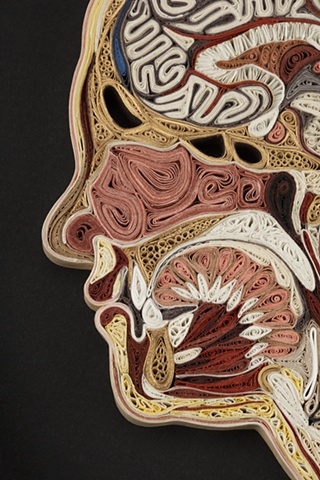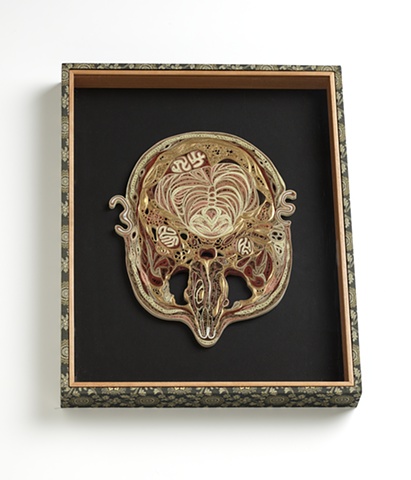 |
| A detail of Profile showing the sinuses, front teeth and tongue. |
 |
This piece represents a lateral section through the head at bridge-of-the-nose level.
|
Lisa Nilsson uses the traditional technique of quilling to create in paper art form. The "Tissue Series" are anatomical cross-sections made of Japanese mulberry paper and the gilded edges of old books. They are constructed by a technique of rolling and shaping narrow strips of paper called quilling or paper filigree. Quilling was first practiced by Renaissance nuns and monks who are said to have made artistic use of the gilded edges of worn out bibles, and later by 18th century ladies who made artistic use of lots of free time. I find quilling exquisitely satisfying for rendering the densely squished and lovely internal landscape of the human body in cross section. Each piece takes several weeks to assemble and begins with an actual photograph of a lateral or mid-sagittal cross section to which she begins pinning small rolls of paper. Depending on its function she rolls the paper on almost anything small and cylindrical including pins, needles, dowels, and drill bits. She even makes the boxes by hand.
I love how she takes a traditional technique, that usually features floral and fantasy designs, and gives it a slightly morbid but educational spin. The work is reminiscent of the surgeon Gunther von Hagen's "BodyWorks". I think this technique could also transla\ate well into fabric as an embellishment. I'd also like to explore biology and anatomy more within my work.
In reference to the second image Nilsson says:
"This piece represents a lateral section through the head at bridge-of-the-nose level. It is life-size. I love how asymmetrical the body looks in cross section. We are so symmetrical on the outside and so asymmetrical on the inside and everything inside fits so perfectly. This is the connection I made to quilling. Rolled pieces of paper are amenable to being squeezed, shaped and shifted to fill a space. I use mulberry paper for its fabric-like strength and flexibility and the sophisticated color palette it is available in."